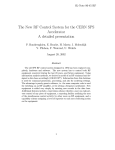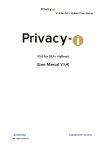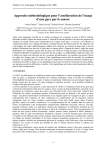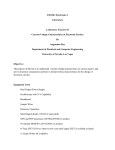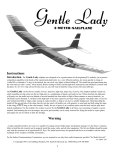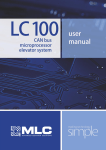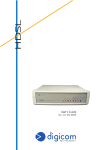Download Band 7 Cartridge Operation Manual
Transcript
ALMA Project Doc #: FEND-40.02.07.00-025-A-MAN Band-7 Cartridge – Operation Manual Date: 2006-03-24 Status: Draft Page: Page 1 of 15 Band 7 Cartridge Operation Manual FEND-40.02.07.00-025-A-MAN Version: A Status: Draft 24th March 2006 Prepared By: Name(s) and Signature(s) S.Mahieu Sylvain Organization IRAM Date 2006-03-24 Approved By: FE Sys Engr Name and Signature H. Rudolf Organization ESO Date yyyy-mm-dd K. S. Saini NRAO Released By: FE IPT Leads Name and Signature G. H. Tan Organization ESO J. Webber NRAO B.Lazareff Mahieu Digitally signed by Sylvain Mahieu DN: CN = Sylvain Mahieu, C = FR, O = IRAM, OU = Frontend Group Reason: I am the author of this document Date: 2006.06.01 15:55:37 +02'00' Date yyyy-mm-dd ALMA Project Doc #: FEND-40.02.07.00-025-A-MAN Band-7 Cartridge – Operation Manual Date: 2006-03-24 Status: Draft Page: Page 2 of 15 Change Record Version A Date Affected Section(s) 2006-03-24 all Change Request # Reason/Initiation/Remarks New document ALMA Project Doc #: FEND-40.02.07.00-025-A-MAN Band-7 Cartridge – Operation Manual Date: 2006-03-24 Status: Draft Page: Page 3 of 15 Table of Contents 1 1.1 1.2 1.3 1.4 INTRODUCTION .................................................................................................... 4 Purpose .................................................................................................................. 4 Scope ..................................................................................................................... 4 Applicable documents ........................................................................................... 4 Reference documents............................................................................................. 4 2.1 2.2 2.3 2.4 DESCRIPTION......................................................................................................... 5 Equipment Definition ............................................................................................ 5 Significant Parameters........................................................................................... 6 Cartridge ESD protection board description ......................................................... 7 Putting the Cartridge, bias module and WCA together. ....................................... 7 2.4.1 2.5 DC Power Requirements ....................................................................................... 9 Quick Overview of the LO driver operation and settings ..................................... 9 2.5.1 LO Driver brief description ................................................................................... 9 2.5.2 2.6 Connecting, Switching ON Power, and establishing Phase Lock ......................... 9 Band 7 Cartridge operation and settings.............................................................. 13 2.6.1 Cartridge Description .......................................................................................... 13 2.6.2 Cartridge components biasing sequence.............................................................. 14 2 ALMA Project Doc #: FEND-40.02.07.00-025-A-MAN Band-7 Cartridge – Operation Manual Date: 2006-03-24 Status: Draft Page: 1 1.1 Page 4 of 15 Introduction Purpose This document is the user guide / manual for the first ALMA Band 7 Cartridge. 1.2 Scope This document applies to the following level-3 work element: FEND-40.02.07.00-024-A-LIS, Band 7 Cartridge#1 CIDL. The statement of work covering this work-package is described in [RD1]. This is a manual for operating the first band 7 Cartridge associated with a Warm Cartridge Assembly (WCA). This document does not include test data from individual assemblies. That data is unit/assembly-specific and is included in a separate document(s). 1.3 Applicable documents The following documents are part of this document to the extent specified herein. If not explicitly stated otherwise, the latest issue of the document is valid. Reference Document Title ALMA Doc. Number [AD1] Band-7 Cartridge Specifications [AD2] Band-7 Cartridge – Experimental A set of documents, including the Procedures for Acceptance Tests present one [AD3] Data formats for cartridge operating FEND-40.02.00.00-016-A-STD parameters [AD4] Front End Integration Center Database FEND-40.09.03.00-007-A-DSN Design Description [AD5] Band-7 Cartridge Acceptance Test Plan FEND-40.02.07.00-008-A-PLA 1.4 – Technical ALMA-40.02.07.00-002-A-SPE Reference documents The following documents contain additional information. ALMA Project Doc #: FEND-40.02.07.00-025-A-MAN Band-7 Cartridge – Operation Manual Date: 2006-03-24 Status: Draft Page: Page 5 of 15 Reference Document Title ALMA Doc. Number [RD1] Band 7 Cartridge Statement of Work FEND-40.02.07.00-001-B-SOW [RD2] Band 7 Cartridge Management Plan Under preparation [RD3] PAI & PAS Procedures for the ALMA FEND-40.02.07.00-005-A-PRO Band 7 Cartridge 2 2.1 Description Equipment Definition The Band 7 cartridge is one of the receiver cartridges which populate the front end dewar. As an illustration, annotated photographs of the first Band 7 cartridge and WCA are presented in Figure 2 and the cartridge baseplate is shown on the Figure 1 below. Its role is to fulfill a certain amount of functional requirements described in [AD1]. For the purposes of these requirements, the cartridge includes the cold optics (feed horn, mirrors, polarizing grids), components needed to couple the LO to the mixers, IF amplifiers, sensors for temperature monitoring and any type of necessary interconnects. Although the cartridge body itself is not part of this Work Element the mechanical mounting of all components depicted in figure 1 so that the requirements mentioned in this document are met is part of this Work Element. All vacuum and cryogenic services are provided by the front end dewar. LO Feedthrough DC Feedthrough IF Feedthroughs Figure 1: Band 7 cartridge baseplate ALMA Project Doc #: FEND-40.02.07.00-025-A-MAN Band-7 Cartridge – Operation Manual Date: 2006-03-24 Status: Draft Page: Page 6 of 15 Figure 2: Left: Complete Cartridge, right: WCA with warm IF amplifiers 2.2 Significant Parameters RF Input port: 275 GHz to 370 GHz extended to 373 GHz LO input port: 283 GHz to 365 GHz IF Bandwidth: 4 GHz dual-sideband, (2SB) upper and lower sideband, centred at 6 GHz ALMA Project Doc #: FEND-40.02.07.00-025-A-MAN Band-7 Cartridge – Operation Manual Date: 2006-03-24 Status: Draft Page: 2.3 Page 7 of 15 Cartridge ESD protection board description In order to protect the cartridge sensitive components (i.e. SIS junctions and HEMT amplifier transistor) from both excessive DC bias and electro static discharges (ESD); a protection board has been inter-staged at the cartridge bias input. ESD protection is realized by parallel-connected 2-terminal devices with appropriate threshold voltages. A special case is the gate voltage of the HEMTs: because they have an internal dividing network for extra protection, the effective voltage range is ±5V. Nevertheless, during the shipment, the cartridge is always sealed within ESD protective packaging material. It should only be moved from and to ESD safe areas. At receipt, the following should be carried out: • Preparation: A clean “ESD safe” area consisting of the following items should be established in any location in the integration center facility where the cartridge is to be handled. o A properly grounded static-dissipative surface on which to place the product o Static dissipative floor and floor mat o A properly grounded conductive wrist strap for each person to wear while in the process handling the product • Unpacking: o Place the shipping container onto the static-dissipative surface. o Open the shipping container and place the ESD protective packaging, containing the cartridge on the static dissipative surface o Cut the antistatic sealing tape with a Utility Knife, remove the cartridge and place it onto the static dissipative surface. Save all ESD protective packaging for later. 2.4 • Any required visual inspection should be performed at this time. • If the cartridge has to be moved to another place, it has to be placed in its antistatic bag. Putting the Cartridge, bias module and WCA together. ALMA Project Doc #: FEND-40.02.07.00-025-A-MAN Band-7 Cartridge – Operation Manual Date: 2006-03-24 Status: Draft Page: Page 8 of 15 In the test setup shown in the Figure 3 below, one can see the different set of equipment involved in the cartridge test. Bias PCI /CAN NI 777357-02 CAN cable J4 WCA Test Cable Module J1 MDM 51 s WCA M&C Interface PC W2000 Labview version 6/7 ( tbd ) Band 7 WCA Plate Cartridge J2 WR10 9 V PS (??) Harmonic generator 30MHz Xtal or Synth +/- 24V PS +/- 15V PS Synthesizer (~12~18 GHz) +/- 6V PS + 6V PS Power supplies and wiring to J2 Figure 3: test setup description • A Personl Computer for the control through a CAN card and a GUI labview code • A CAN cable between the pc and the Cartridge Test Monitor and Control module • The test cartridge Monitor and Control module • The WCA test cable • The WCA itself • The Bias Module • The cartridge • Necessary equipment for phase locking • DC power supplies. 1. Fit the bias module onto the cartridge baseplate with two screws 2. fit the WCA onto the cartridge paying attention to the blind mate connections (LO, DC and IF) ALMA Project Doc #: FEND-40.02.07.00-025-A-MAN Band-7 Cartridge – Operation Manual Date: 2006-03-24 Status: Draft Page: Page 9 of 15 3. engage the overall assembly into the cryostat using the necessary tooling (cartridge loader) and making sure that the cold cartridge is properly engaged 4. fit the baseplate M8 screws 5. fit the DC power supply cable at the back of the WCA 6. fit the serial input/output cable at the back of the WCA 7. make sure that the power supplies overcurrent are set to the correct value (see 2.4.1) 8. follow the 2.5 chapter step by step explanations to power the WCA and cold cartridge assembly up. 2.4.1 DC Power Requirements +6 V (1.5 A, 1A); +15 V (1.2 A); -15 V (50 mA); +24 V (0.25 A); +9V (0.5A, CAN interface); +8V (0.5A) (warm IF amplifiers) 2.5 Quick Overview of the LO driver operation and settings 2.5.1 LO Driver brief description The LO driver operation is only briefly described, since this is not the scope of this document; for more detailed information, please refer to the LO Driver user manual. The First Local Oscillator (LO) Driver Assembly generates the microwave signal needed to drive the coolable frequency triplers in the front-end cartridge (which in turn generate the LO power to pump the SIS-junction based down-converters). It does so by frequency multiplication and subsequent amplification of the 15 – 21 GHz signal from a YIGoscillator. The output is phase locked to the reference signals provided by the ALMA LO reference distribution system / Lab. synthesiser. 2.5.2 Connecting, Switching ON Power, and establishing Phase Lock Once the WCA is mounted onto the cartridge baseplate, • Ensure forced-air flow across the heat-sink on the YIG tuned oscillator assembly ALMA Project Doc #: FEND-40.02.07.00-025-A-MAN Band-7 Cartridge – Operation Manual Date: 2006-03-24 Status: Draft Page: • • Page 10 of 15 With the power supply turned OFF, make connections to the 15-pin D-type serial I/O connector and the 25-pin D-type DC power connector on the back of the LO driver assembly. Applying power at this point should turn on the LO driver assembly and activate the CAN interface between the pc and the WCA/Cartridge for later monitoring and control activities. Finally, apply the FLOOG signal (0 dBm) to the coaxial connector located on the back of the LO driver assembly and the LO reference signal (photodiode output, minimum 50 nW) to the wave-guide marked as such on the PLL module At this point, the LO driver assembly is ready to establish phase-lock to the input reference signals and be used. CAN Interface setup: The ‘CAN interface’ control on the ‘CAN Interfaces & Execution’ tab should have the same values as the CAN Interface is configured to use. In our case, ‘CAN1’ is the correct value. The AMBSI1 inside the hardware is configured to have the node address 13 (hex) by default and the node address in the software is set to the same value by default. Press ‘Scan & Connect to CAN bus’ to find the Bias Electronics on the bus. If everything is OK, you should get a message saying “Program running. Do not turn off power to receiver modules” ALMA Project Doc #: FEND-40.02.07.00-025-A-MAN Band-7 Cartridge – Operation Manual Date: 2006-03-24 Status: Draft Page: Page 11 of 15 Select the “SIS/Amp. Bias” and “LO” tabs under the “select monitor points” pane and tick every point to be monitored. Select the “LO” and “SIS” tab under the “SIS / Ampl / LO Control” pane on the monitor and control GUI and enter 14.987 GHz and 20.977 GHz for “YTO Low freq” and “YTO High freq” respectively. Select whether the PLL should “Lock YTO above” or “Lock ALMA Project Doc #: FEND-40.02.07.00-025-A-MAN Band-7 Cartridge – Operation Manual Date: 2006-03-24 Status: Draft Page: Page 12 of 15 YTO below” (one-sixth of) the LO reference signal frequency. Next, manually set the YTO to the appropriate target frequency by entering the frequency and pressing the “set” button. The target frequency is (one-sixth of the LO reference frequency ± the FLOOG frequency). The sign is determined by the selection (made earlier) of whether the YTO should lock above or below one-sixth of the LO reference signal frequency. An approximate number will do. For instance inputting one-sixth of the LO reference frequency will work just fine here; the phase locking algorithm will fine-tune this setting later. Next set the IF attenuators to about 3 dB to begin with (more if the LO reference signal is greater than 50 nW). Click on the “Lock LO” button. The appropriate LED should light up on the GUI (under “LO Monitors” tab) indicating acquisition of lock to the desired sideband of the LO reference signal. Adjust the IF attenuator setting so that the output of the IF level detector is about -1.9 V. ALMA Project Doc #: FEND-40.02.07.00-025-A-MAN Band-7 Cartridge – Operation Manual Date: 2006-03-24 Status: Draft Page: Page 13 of 15 The small rectangular LEDs (on the GUI) placed next to the monitored parameters under the “LO Monitors” tab should be all green. Any red LED indicates that the value of the corresponding parameter is out of its optimal range. 2.6 2.6.1 Band 7 Cartridge operation and settings Cartridge Description The LO triplers driven by the LO driver assembly are pumping sideband separating mixers junctions through the LO/RF coupler. Then, the 2SB assemblies, made of an RF ALMA Project Doc #: FEND-40.02.07.00-025-A-MAN Band-7 Cartridge – Operation Manual Date: 2006-03-24 Status: Draft Page: Page 14 of 15 coupler followed by an IF hybrid coupler, in turns, produce two IF sideband signals called USB and LSB. These IF signals are then amplified by three stages cooled HEMT amplifiers and room temperature IF amplifiers. Furthermore, in order to suppress the Josephson current, supraconducting wire magnets are used. Moreover, temperature sensors are used to monitor each of the cartridge stage temperature. All of these cartridge components require a DC supply circuitry as well as a PC interface to monitor and control the bias lines. 2.6.2 Cartridge components biasing sequence HEMT biasing: Next, select the “SIS/Amp” tab under the “SIS / Ampl / LO Control” pane on the monitor and control GUI and enter the required drain and current combinaison for each of the four amplifiers mounted into the cartridge (in Pol0 and Pol1) in agreement with the table provided by the manufacturer. Pressing the “enabled/disabled” button and “set” buttons for each of the stages voltage/current combinaisons will enable the amplifiers and set the bias points correctly. That can be checked in the “SIS/Ampl. Monitors” pane. Junction polarization: The next step is to polarize the junctions correctly, in agreement with the table provided by the cartridge manufacturer, bearing in mind that the junction voltage/current are LO frequency dependant. • • • • With zero volt applied on mixer junction bias line, adjust the corresponding mixer magnet current until the Josephson current reaches a minimum. Once the Josephson current has been reduced to a minimum, apply the correct bias voltage read from the table provided. The junction is then ready to be pumped by the LO signal that can be adjusted in the “LO” tab under the “LO” pane. This is performed by adjusting the corresponding polarization (either A or B) LO power amplifier drain voltage. Once the mixers bias points are set correctly, receiver tests and/or observation can be carried out. ALMA Project Doc #: FEND-40.02.07.00-025-A-MAN Band-7 Cartridge – Operation Manual Date: 2006-03-24 Status: Draft Page: Page 15 of 15















